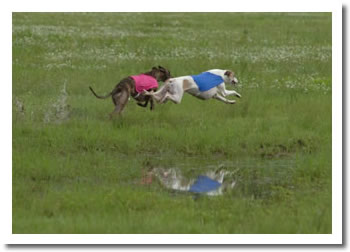
|
It
is generally agreed that the Whippet, as we know it today, was developed
in Northern England during the mid to late 19th century. |
 |
|
|
The Whippet, an English Greyhound in miniature, is a sporting dog of the first flight as well as a very charming, affectionate, and intelligent pet. He is the fastest domesticated animal of his weight, capable of speeds up to 35 miles per hour. Though his main forte is as a racedog, he is a rabbit courser of great ability. His rat-killing feats, too, are nearly equal to those of the most hard-bitten terriers. As an animal of beauty, grace of outline, and smoothness of action, he stands near the top in the realm of dogdom.
The early specimens differed a great deal from our best present-day dogs. Small Greyhounds were crossed with several small terriers, (including possibly the Bedlington Terrier), to produce a small, swift hound capable of hunting rabbits and other small game. It
was not until a much later date that fanciers added an infusion of the
Italian Greyhound blood which aided so materially in improving type. |
||
|
Eventually the Whippet was used in the sport of straight racing which had its inception in Lancashire and Yorkshire where it still flourishes today. Here the colliers nick-named them "poor man's race horse" . During this era, the whippet belonged mainly to the working class people of England. These were factory and mine workers in northern towns near Manchester and Liverpool, who worked hard and lived simple lives. On non-working days, owners raced their whippets in fields and on town roads. These races became known as "rag races," probably because a piece of cloth was used as a lure. The dogs typically ran a straight 200 yard track. |
 Photographer: Shot On Site |
|
|
Today, Whippets are the most popular of the hound breeds at dog shows. Their size, short coat, and agreeable temperament make them both the perfect family pet and an ideal exhibition dog. Their quiet deportment in the ring makes them comparatively easy to show, as is attested by the winnings of numerous novices who handle their own entries.
|
||